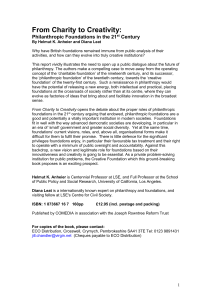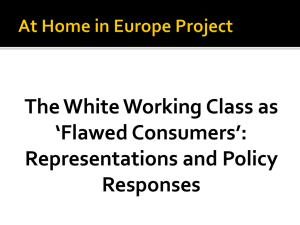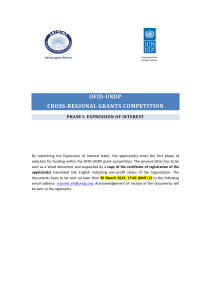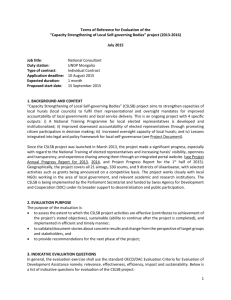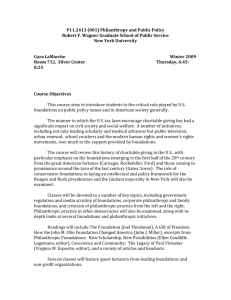view Strategy for Engagement with Foundations
advertisement
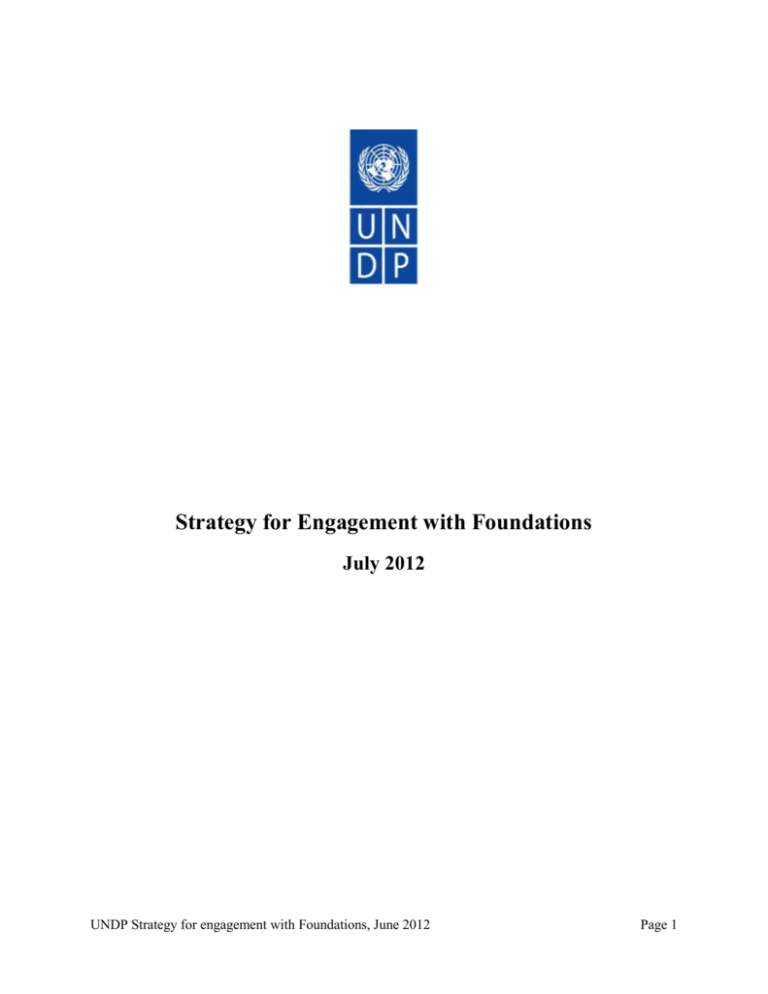
Strategy for Engagement with Foundations July 2012 UNDP Strategy for engagement with Foundations, June 2012 Page 1 Contents 1. 2. Introduction ........................................................................................................................................... 3 1.1 Purpose of document..................................................................................................................... 3 1.2 A changing development landscape .............................................................................................. 3 Background ........................................................................................................................................... 5 2.1 Status of UNDP’s work with Foundations .......................................................................................... 5 2.2 Foundations Value Added................................................................................................................... 7 2.3 3. UNDP’s value added..................................................................................................................... 9 The strategic vision for a new relationship with Foundations ............................................................ 10 Annex A: Excerpt from the UNDP Management Response to the Evaluation of UNDP Partnership with Global Funds and Philanthropic Foundations. ............................................................................................ 12 Annex B: Figures and statistics................................................................................................................... 14 Annex C: The most influential philanthropic events which provide opportunities for UNDP engagement .................................................................................................................................................................... 15 UNDP Strategy for engagement with Foundations, June 2012 Page 2 1. Introduction 1.1 Purpose of document To strengthen UNDP’s external relations and advocacy, and as part of the “Agenda for Organizational Change”, UNDP is carrying out organization-wide consultations to strengthen and rationalize corporate partnerships. As part of this process, the corporate External Relations and Advocacy Framework (ERAF) was endorsed by the OPG and the EG at the end of 2011. As stipulated in the ERAF and the 2012 Annual Business Plan, UNDP is developing a corporate strategy for how it engages with Foundations/Philanthropic organizations.1 The new strategy for engagement with philanthropic foundations follows the recommendations of the Management Response to the Evaluation of UND’s Partnership with Global Funds and Philanthropic Foundations.2 1.2 A changing development landscape The international development landscape has changed rapidly in the past decade. In the new development environment, the importance of foundations and philanthropic capital has increased. A number of factors make it imperative for UNDP to engage strategically in partnerships with foundations: Foundations are becoming full-fledged development partners rather than donors and expect to be closely involved in diagnosing and addressing development challenges. Foundations, jointly with partners, share common development outcomes and collaborate to mobilize resources and actions to bring about sustained and transformational change. Foundations are steering away from funding single or ad hoc projects but instead plan multi-asset interventions and leverage funding with advocacy, networks, knowledge and experience. Foundations are interested in working with governments. Historically foundations have primarily worked with civil society and NGOs.3 However, more and more they are coordinating efforts or even directly engaging with national governments as their development partners. Foundations are interested in developing national capacities. Foundations have demonstrated interest in developing capacities and relations among civil society and government institutions while emphasizing greater civic engagement, transparency, accountability and advocacy for human rights. While the definition of philanthropy may vary, for the purpose of this strategy it is defined as “private funding in the public interest”. The philanthropic sector comprises a diverse set of actors, including wealthy individuals, private and public foundations and organizations focused on corporate social responsibility (corporate foundations of CSR branches of companies). There is also a growing trend of venture philanthropy known as ‘impact investing’ that has an explicit commercial interest in socially oriented projects. 1 2 UNDP EG Decision, 21 May 2012. See annex 1 for Management Response regarding the new strategy for philanthropic foundations. Lessons learnt from the Evaluation are used in the strategy. 3 For example, US-based foundations such as the Carnegie Foundation, the Ford Foundation, the Mott Foundation and the Soros Foundation supported civil society development right after fall of communism in the early 1990s in Eastern Europe with funding for expertise, research and capacity building. Bilateral donors entered the stage later and built on the catalytic investments from the foundations. (Source: Joan Spero, 2010) UNDP Strategy for engagement with Foundations, June 2012 Page 3 There is a growing convergence in the interests of foundations and multilateral organizations as foundations engage more directly with development partners.4 o Foundations are moving towards solutions that strengthen systems and away from single project outputs. In the past, foundations mostly distributed grants for small-scale and single-issue projects in isolation. In recent years, they often carefully choose development challenges and plan their interventions strategically. The focus of foundations has shifted toward leveraging funding with advocacy, networks and knowledge to address development issues; o Foundations are increasingly committed to aligning interventions and results with national development priorities and policy at the country level. Foundations often work in coalitions and in coordination with national governments and other in-country development partners and seek cooperation from both the public and private sectors; o Foundations are increasingly interested in adopting accountability codes and good practices of transparency and governance. Development trends create an opportunity to integrate philanthropic foundations into emerging global development platforms such as the post-Busan Partnership on Effective Development Cooperation. Philanthropic funding is largely aligned with UNDP’s priorities. Although foundations might not be explicitly structuring funding decisions around the MDGs, a substantial share of their philanthropic giving directly overlaps with international development Goals.5 6 International philanthropic giving is increasing. Over the past decade, philanthropic organizations have emerged as potent players in the development arena alongside official development aid. It is estimated that annual philanthropic contributions for international aid projects total between US$4.5 billion and US$8 billion.7 Thus, foundations are and will continue to be important actors in development. Philanthropic giving is also increasing in emerging countries, such as BRICs. Most philanthropic contributions in emerging economies do not come from institutions 8 but wealthy individuals who are ensuring that funds aim at the adoption of more modern frameworks that measure results. These individuals often utilize knowledge and experience from industrialized countries for organizing charitable giving, yet also seek out local solutions to ensure sustainability and respond to local market demands. 4 Nashua Watson, 2012. (Source: the Bellagio initiative) Programmes related to reducing poverty and hunger and fighting HIV/AIDS and other diseases account for the largest share. (Source: Foundation Centre, 2010) 6 Annex A Figure 1 illustrates philanthropic expenditure per thematic areas in the US and Europe. 7 Due to a lack of harmonized and internationally recognized reporting mechanisms, levels of philanthropic money to international development are disputed. These numbers are taken from two recognized sources, the Foundation Center and the Hudson Institute, 2009. 8 For example, the Muslim philanthropy in the Gulf region amounts to approximately US$15-20 billion dollars a year; however, only US$2 billion is channeled through foundations that publish data. Source: McKinsey and Company (2009), Increasing the Impact of ‘Giving’ in Saudi Arabia) 5 UNDP Strategy for engagement with Foundations, June 2012 Page 4 2. Background 2.1 Status of UNDP’s work with Foundations Country Offices and regional centres, with coordination and support from HQ, have predominantly managed long-term country partnerships and project-oriented relationships with foundations. Examples of long-term partnerships include Soros Foundation, the Al Maktoum Foundation, and the Gates Foundation as well as corporations such as the Coca Cola Foundation, the Ikea Foundation and the MTN Foundation. In addition, the Evaluation of UNDP Partnerships with Global Funds and Philanthropic Foundations includes lessons learnt from the collaboration with and development impact resulting from relationships with the Soros, Al Maktoum and Gates Foundations.9 Annex B also describes examples of successful foundation partnerships. All levels of the organization, including country offices, regional centres and HQs, are involved in partnerships and relationships with foundations which make it difficult to establish with certainty the full extent of UNDP’s relationship with the philanthropic sector. From a financing perspective, estimates show that UNDP received more than US$200 million in foundation grants for programming activities between 2001 and 2011. As per Annex A, most of these grants came from large foundations, with 97 percent from the top 10 foundations. In 2012, there are approximately 20 on-going grants ranging from US$100,000 to US$20 million. The average grant size is approximately US$4.5 million. Box 1 : Empowering Rural Women in India ( The Ikea Foundation) In 2009, IKEA and the UNDP country office in India launched a 5-year programme (5.6 million Euro) to boost leadership and literacy among 50,000 women in Uttar Pradesh by forming social cooperatives or Self-Help Groups (SHGs). These SHG support Social, Economic and Political Empowerment for women by providing reading/writing classes, training in microfinance and entrepreneurial management and legal entitlements and voting rights information . By 2011, the Programme had established a dairy enterprise employing over 12000 women, raised SHG-member incomes by 20%, andproviding democratic training to 13000 women. Based on a successful pilot and trusted relationship, the IKEA Foundation increased the funding to over 30 million Euro in April 2012 to increase the scope of the project to cover 2.2 million poor rural women families in approximately 20,000 villages in some of India’s poorest districts. Box 2: Supporting Agricultural Transformation in Ethiopia (The Bill and Melinda Gates Foundation) Agriculture employs over 80% of Ethiopia’s labour force and accounts for over 40% of its GDP. The UNDP country office in Ethiopia has signed an $11.8 million grant agreement with the Bill and Melinda Gates Foundation to support the Ethiopian government operationalize the newly formed Ethiopian Agricultural Transformation Agency (EATA). The EATA supports 6-7 key areas including seed, irrigation, soil fertility and markets/cooperatives to double crop yields by 2016 and implement the government’s 5-Year National Agricultural growth plan. The plan aims to increase agriculture production by 15% to increase food security and generate livelihoods in the country. In early 2012, the collaboration expanded with a financial inclusion programme for the farmers. 9 Evaluation of UNDP Partnership with Global Funds and Philanthropic Foundations, forthcoming in June 2012., pp 74-82 UNDP Strategy for engagement with Foundations, June 2012 Page 5 Lessons learnt from past collaboration Relations between UNDP and Foundations have been of limited strategic importance: The foundations evaluation10 found that there is little evidence of high-level sustained dialogue between foundations and UNDP which embraces strategic collaboration with a focus on shared outcomes.11 The opportunistic and project-focused relationships have narrowed the current relationship to resource mobilization. Therefore, the potential to maximize the developmental benefits and mainstream the human development perspective into the collaboration present an opportunity for both parties. Partnerships have been weakly aligned to UNDP’s priorities with limited financial impact for UNDP delivery: The evaluation also found that collaboration has not contributed effectively to the achievement of shared development goals, had limited financial importance and was weakly aligned with UNDP priorities.12 Partnerships with Foundations have high transaction costs: Consultations with UNDP’s Bureaus and country offices show that resource mobilization from foundations has high transaction costs, especially when these opportunities are ad hoc and unpredictable. UNDP’s current programming tools treat foundations as donors rather than development partners. Partnering tools, such as memoranda of understanding and cost – sharing agreements have offered limited opportunities for full-fledged collaboration.13 UNDP is not yet a partner of choice for foundations: With few exceptions, foundations have not been convinced of UNDP’s expertise in monitoring and evaluating development results or of UNDP’s leadership in development arena. Although influential philanthropic events and research address international development, UNDP has not been featured at these conferences.14 Many foundations perceive UNDP as slow, bureaucratic, and process-driven with high transaction costs. Compared to other UN agencies (such as UNICEF and WFP) UNDP is a less attractive partner since it has a less clear sectoral mandate and does not have national committees (like eg. UNICEF) which facilitate collaboration using national legal frameworks. UNDP must ensure due diligence: Foundations, as any partner, require that due diligence is completed so as to mitigate reputational risk especially for those associated with large corporations. UNDP has not leveraged its resources to foster enhanced partnerships with foundations: UNDP Bureaus have minimum human resource capacity to develop relations, policy and programme 11 The exception has been a strategic relation between UNDP and the UN Foundation. Evaluation of UNDP Partnership with Global Funds and Philanthropic Foundations, forthcoming in June 2012. 13 Referring to current UNDP POPP, policy and procedures for engagement with foundations, September 2011 14 None of the regional conferences in Asia, Africa, Europe, the Americas featured UNDP senior leadership, whereas for example heads of other UN agencies such as UNICEF, UN Women have been invited as key note speakers addressing human development issues in 2011-2012. 12 UNDP Strategy for engagement with Foundations, June 2012 Page 6 opportunities in partnership with foundations. In addition, there is no coordination among United Nations organizations regarding foundation partnerships. There are beginning to be exceptions, however. For example, the Ikea Foundation appreciates the collaborative efforts with UNDP in India and for the documented results (see box 1 which describes how Ikea partners with UNDP India on women’s empowerment). The Gates Foundation has also valued its collaboration with the UNDP Ethiopia Country Office for effectively convening policy dialogues with stakeholders (see box 2 below)15regarding the Ethiopian Agricultural Transformation Agency Box 3: Every Drop Matters (The Coca Cola Foundation) “Every Drop Matters” is a global partnership between the UNDP and the Coca Cola Foundation that aims to increase access to safe drinking water, sanitation and environmentally sound water resource management by outreach and awareness activities. The collaboration started in 2006 in Eastern Europe and Central Asia where UNDP and Coca Cola jointly distributed small grants, up to USD$ 50 000 to communities for innovative projects which enhanced water access and quality. Examples included establishing a waste water treatment plan on the Gacka River to protect the indigenous river trout, building rooftop rainwater harvesting plans in Central Anatolia and upgrading damaged water supply networks in Kazakhstan. In 2011, the relationship expanded to a global programme with the Coca Cola foundation implemented in 25 countries in Europe, Central Asia, the Middle East and Asia-Pacific. UNDP and Coca Cola work together on public advocacy campaigns that promote access to clean drinking water with joint messages and outreach to media. The program now has three major objectives: 1) to continue to provide communities sustainable access to safe drinking water, 2) to give grants to community-based organizations that implement innovative environmentally-sound water management initiatives, and 3) to advocate for replication and scaling up of best practices. 2.2 Foundations Value Added Foundations have a number of characteristics that make them attractive partners for UNDP: Foundations as thought-leaders: Foundations are increasingly investing in cutting edge research and testing innovative ideas. They are thought-leaders in many sectors and influence international policies.16 For instance, in promoting sustainable agriculture in Asia and Africa, foundations have contributed to problem analysis, funded research, invested their social capital in risky and cutting- 16 One example of successful commitment to innovation is the Rockefeller Foundation, which provided support to the 'Green Revolution' in Asia from the 1940s to the 1970s. Today, the Rockefeller Foundation works with the Gates Foundation to emulate these successes through the Alliance for a Green Revolution in Africa, launched in 2006. Another example includes Ford Foundation which established TrustAfrica, a pan African network aiming to support growth of indigenous African philanthropy. Today TrustAfrica is co-led by African foundations such as Tony Elumelu foundations and others. UNDP Strategy for engagement with Foundations, June 2012 Page 7 edge pilot initiatives, and built networks of collaborators (including governments). UNDP would gain access to new development knowledge, networks and people through enhanced collaboration. Foundations have the capacity to run high-profile advocacy campaigns: Many foundations are effective in mobilizing media attention around global development issues such as climate change, food security or public health.17 Foundations are an important partner in profiling global advocacy and communication campaigns on core development issues. Foundations forge innovative private public partnerships: Foundations are in a good position to play a catalytic role between private or public investors and social enterprises or entrepreneurs by providing venture capital. There is a recent trend of ‘impact investing’ where philanthropic or patient capital is used in financial innovations that solve development problems using an entrepreneurial, results-oriented framework.18 Corporate philanthropy has championed this trend. By working more closely with core business, corporate philanthropy leaders help to create new resources and ideas that magnify corporate benefits to society.19 The UNDP private-sector strategy has addressed this trend in an effort to collaborate with the private sector in the development of inclusive markets. In addition, through long standing partnering history with companies, UNDP advances the trend by making it relevant and action oriented in developing countries. For example, see box 3 for the relationship between Coca Cola and UNDP which evolved from a charitable regional to a strategic global initiative linked to the company’s core business. The partnership is a great example of how a shared outcome creates an opportunity for mobilizing various UNDP and Coca Cola assets to collectively bring about the outcome and ultimately improve the lives of beneficiaries by giving access to safe drinking water. Philanthropic funding is an important source of social risk capital: Public monies and institutional funding typically have more restrictions than private capital which seeks to address social issues. Philanthropic funding is therefore a valuable source of social risk capital that is flexible and can be utilized in key development areas perceived to have the greatest benefit. Although philanthropic funding for development is significantly lower than that from traditional donors, its flexibility and ability to withstand risk create an important new window for UNDP to jointly address some of the most relevant development needs in an innovative and less burdensome fashion. Foundations encourage the growth of indigenous philanthropy: Evidence shows that appropriate government policies and institutional incentives have triggered dynamic growth of local philanthropic organizations.20 This trend is prominent in emerging countries that enjoy an expansion of private wealth. Institutionalized solutions to philanthropy increase transparency and 17 Bill Gates and Carlos Slim are prominent examples in global health and ICT for development issues. Philanthropic funding typically acts as angel investor offering capital at early stages of enterprise development and seeks return in the long term, typically over 10 years. Investments aim to operationalize inclusive business models that offer affordable goods and services to the poor and initial successes of returns to investors have been found in sectors such as energy and agriculture. The typical financial tools used for this purpose range from loans and equity to social bonds and social stock exchanges. (Source: From Blueprint to Scale, by Monitor, 2012 http://www.mim.monitor.com/blueprinttoscale.html 19 Increasing Impact, enhancing value. A Practitioner’s Guide to Leading Corporate Philanthropy, Council on Foundations, 2012. 20 Most typical policies include fiscal, research and capacity development. 18 UNDP Strategy for engagement with Foundations, June 2012 Page 8 the effectiveness of giving. A strong philanthropic culture creates resilience and an ability to fundraise for local development. For these and other reasons, partnerships with foundations can augment the possibilities for UNDP’s work. While foundations have different operational/funding models than traditional donors and thus new and innovative operational opportunities should be found to decrease transaction costs and facilitate collaboration. 2.3 UNDP’s value added UNDP has a solid value proposition to offer foundations as well. This includes: Global presence: UNDP’s global presence allows wide dissemination of new ideas, research, and technology through its country offices and regional centers. Its reach extends beyond capitals to urban and rural centres where philanthropy and social financing vehicles often have neither a presence nor access to local government. Foundations, which mostly have very limited country operations, can leverage UNDP’s network to access national and sub-national partners. Access to governments and decision makers: UNDP as the manager of the Resident Coordinator system, has significant influence with government decision-makers in developing countries. UNDP can access governments in ways that philanthropic foundations normally cannot and as a result, can offer philanthropic foundations a window into national policy priorities and the best practices in local philanthropy innovation. UNDP can bring leadership and legitimacy to the philanthropic sector. Knowledge and expertise in development: With its local knowledge, expertise in practice areas, and long experience in implementing development projects from a human-development perspective, UNDP brings a wealth of experience in development to the table. Furthermore, through its size and level of influence, UNDP has a broad convening capacity to gather organizations, experts, and leaders from around the world to consider issues of mutual interest. Scaling up sustainable development solutions: UNDP has experience in scaling-up successful development projects. Philanthropists, especially those who are focused on innovative approaches in philanthropy, value UNDP’s influence with governments that can allow for scaling up successful pilots and models. UNDP also has access to the donor community and governments to leverage resources for scaling up successful programs. Common areas of interest between UNDP and Foundations UNDP interests and competencies Common interests Foundation interests/competencies Long-standing expertise in sustainable human development Joint efforts to address challenges of sustainable human development Growing interest in long-term global development issues Experience in working in multistakeholder partnerships for development Opportunity to broaden and deepen coalitions for sustainable human development Growing recognition that partnering can be effective in achieving sustainable change UNDP Strategy for engagement with Foundations, June 2012 Page 9 UNDP has a long standing experience in developing national capacities in development Concentrating efforts to support change and national capacities in development Foundations have an emerging focus on the development of national capacities UNDP supports strong UN coherence Coordinating efforts/ issues of common concern between UN development agencies and partners can increase development impact and lower transaction costs Emerging interests in collaboration with national governments as well as other development partners UNDP has policy advisory functions to governments in finding transformative solutions to sustainable human development Joint efforts to invest in cutting-edge areas to find new public policy and development solutions Social risk capital for investments in technologies and development pilots UNDP seeks new ways of enhancing efficiency and effectiveness in development and aid coordination Investing in innovative ways to achieve higher efficiency and effectiveness as well as sustainability in delivering development results Investing in new institutions and solutions that emphasize efficiency, transparency and scale in achieving development results. Investment in ‘impact investing’ or social finance, whereby philanthropic funding ‘leverages’ reach and impact far beyond the initial investment 3. The strategic vision for a new relationship with Foundations The overall vision for a new relationship with Foundations is to support the philanthropic sector’s contribution to international development by engaging in long term partnerships which strategically contribute to UNDP high impact development results. Engagement with foundations should be built on identified shared development outcomes and concurrently bring to focus the sustainable human development perspective.21 All partnerships should be anchored in on-going dialogue between UNDP and foundations to maintain the focus of UNDP Strategic Priorities. Relationships with foundations should be pursued by country offices, regional centres as well as HQ. In planning outreach to foundations, UNDP approach should be strategically narrow in order to forge long term partnerships that drive solutions to development challenges. Partners should leverage each other’s comparative advantages and contribute to development results. UNDP should position itself at influential UNDP’s work overall is based on the pursuit of human development. The development discipline has refocused over the years toward an embracement of ‘human development,’ as pioneered by Amartya Sen and Mahbub ul Haq and highlighted by the annual global Human Development Reports issued by UNDP. This has helped development move away from a narrow focus on GDP growth to a process encompassing the range of initiatives that can expand peoples’ freedoms, choices, and capabilities to live lives that they value. In addition to GDP, UNDP’s Human Development Index, which benchmarks countries’ progress, ,takes account of access to health services and education. 21 UNDP Strategy for engagement with Foundations, June 2012 Page 10 philanthropic events as a global partner in sustainable human development in issues aligned with UNDP priorities. The following three goals for 2012-2015 will contribute to realizing the vision: 2012- 2013 Outcome 1: Strengthened global engagement with foundations to strategically position UNDP Objective 1. Target new and existing partner foundations to establish/improve regular dialogue to define areas of mutual interest for increased collaboration in the longer term. Objective 2. Improve UNDP’s knowledge -base and information sharing about the philanthropic sector and its possible role as a development partner through trend analyses and knowledge management particularly in emerging economies which have high growth potential. Objective 3. Advocate for foundations to contribute to the post Rio and post 2015 development agenda. Outcome 2: Operational bottlenecks that are currently inhibiting closer collaboration overcome Objective 1. Review current UNDP policy and procedures for engagement with foundations to eliminate unnecessary bottlenecks and offer new/simplified instruments for collaboration. 2013 -2015 Outcome 3: Implement three to five high impact interventions which demonstrate the added value of the UNDP/Foundations strategic partnership for enhanced development results Objective 1: Using the new UNDP Strategic Plan and the UNDP Annual Business Plans, and based on the successful implementation of Outcomes 1 and 2 above, track, demonstrate, and assess enhanced development results based on UNDP/Foundations development partnerships.22 Some current priority areas of UNDP (2012 ABP) Some possible areas for dialogue and future collaboration Some future interests voiced by Foundations Priority 1: Contributing convincingly and influentially to the debate on a post-2015 development agenda that includes the outcomes of Rio+20 and addresses a ‘new generation’ of opportunities and risks that centre upon inclusion and equity, resilience and sustainability (…) . The future of international development agenda, including post 2015 and post Rio which are of interest to both, foundations and UNDP such as: Global policy discussions on the future of the post-2015 development agenda that tie the Sustainable Development Goals with the Millennium Development Goals To invest in research and consultations on the future of international development agenda with specific interests in issues such as resilience, inclusion and equity. Sources: Global Philanthropy Forum 2012, Council on Foundations Annual Conference 2012, Foundation Center, 2012, WINGs 2012, European Foundation Centre, Asia Foundation, African Grantmakers, 22 UNDP Strategy for engagement with Foundations, June 2012 Page 11 - - - - Priority 4: Advocacy and actions stepped-up at global, regional and country levels targeted at Rio+20 and new environmental finance mechanisms, organised around climate change, DRR, poverty reduction and gender equality. Priority 10: Substantive options for a post2015 development agenda proposed by UNDP to address inclusion and equity, resilience and sustainability. Integrate environmental protection issues into social protection schemes and social justice, including ensuring access to sustainable energy, Develop new economic models that build inclusive markets and create opportunities for the poor and excluded, Develop new forms of innovative financing for development. Involve foundations in the framework of global partnership for development and coordination of aid at global and country levels. Identifying new resources to address sustainability issues such as climate change. Investing in innovative forms of financing such as “impact investing” or “social bonds” that showcase how mainstream finance can simultaneously make profits and address social issues. Innovative approaches for community consultation and participation using social media and other new forms of communication and participation To address the themes of the Rio+20, Busan, and post 2015 agenda such as food security and sustainable agriculture, jobs, sustainable cities and energy in broad coalitions with partners Policy innovations which encourage local private wealth to be channeled transparently and service public interest using accountable and efficient legal and institutional frameworks. Creating enabling legal and institutional environment for philanthropic capital to grow in countries Annex A: Excerpt from the UNDP Management Response to the Evaluation of UNDP Partnership with Global Funds and Philanthropic Foundations. P16: “The new strategy for the engagement between UNDP and philanthropic foundations aims to reposition the organization vis a vis the new developments in the philanthropic sector and embrace the new partnering opportunities. It focuses on the strategic collaboration for finding common solutions to development, with an emphasis on mainstreaming sustainable human development. The strategy recognizes a wide range of cash and non-cash resources and assets that foundations offer and recognizes the new value of the proposition of foundations in international development. It outlines new collaboration models where foundations are positioned as development partners rather than donors and offers space for working together in UNDP Strategy for engagement with Foundations, June 2012 Page 12 policy discussions, advocacy and problem analysis. Finally, it recognizes foundations as a source of valuable development knowledge”. UNDP Strategy for engagement with Foundations, June 2012 Page 13 Annex B: Figures and statistics Figure 1: Foundations’ contributions to UNDP between 2002 and 2011 (%) Figure 2: A snapshot of the donation patterns of US and European foundations shows similarities with UNDP priorities UNDP Strategy for engagement with Foundations, June 2012 Page 14 Annex C: The most influential philanthropic events which provide opportunities for UNDP engagement Conference Details Time Philanthropy in Asia Summit The largest philanthropic event for Asia based organizations with an emphasis on sustainable development. October 2012 African Grantmakers The largest event for philanthropies in Africa. November 2012 The Global Philanthropy Forum, US The event is recognized as one of the few philanthropic events that addresses the issues of global philanthropy and long term development. Well attended by senior development practitioners as well as philanthropists from all over the world. Spring 2013 Corporate Philanthropy Summit, Centre for Encouraging Corporate Philanthropy, US The largest corporate philanthropy event in the US with over 100 largest multinational companies (mostly US origin) attending. The agenda emphasizes the corporate impact on long term development. Spring 2013 European Foundation Centre [EFC] Annual conference, Europe The largest gathering of foundations from Europe and North Africa with strong emphasis on international development. It is attended by over 500 philanthropic organizations. Spring 2013 The Arab Foundation Forum The largest and most prominent conference for the Arab based foundations with an emphasis on sharing experiences and learning. Spring 2013 UNDP Strategy for engagement with Foundations, June 2012 Page 15
